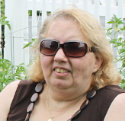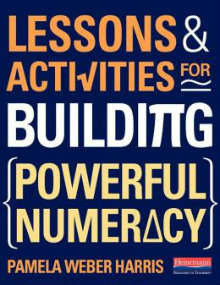Help Students Develop a Sense of Numeracy
Lessons and Activities for Building Powerful Numeracy
By Pamela Weber Harris
(Heinemann, 2014 – Learn more)
 Reviewed by Lynne Menechella
Reviewed by Lynne Menechella
How many of you have students who do not think about whether their answers make sense? Or students who use whatever method you taught them last for all kinds of problems, appropriate or not? The book Math Lessons & Activities for Building Powerful Numeracy gets students thinking about the reasonableness of their answers and makes them more flexible mathematical thinkers at the same time.
 This book is a companion to Weber’s book Building Powerful Numeracy for Middle & High School Students (2012). I did not read the first book but it apparently explains all the research behind the content of this second book.
This book is a companion to Weber’s book Building Powerful Numeracy for Middle & High School Students (2012). I did not read the first book but it apparently explains all the research behind the content of this second book.
This sequel is full of detailed student- and teacher-led activities that can be covered in less than 15 minutes each. The time frame is perfect for my pull-out classes since I have about 20 minutes to work with each grade level, and I anticipate needing a few extra minutes since they are remedial students. I liked that the activities are structured for immediate use. Examples of teacher/student dialogue help the teacher understand the rationale behind the activities.
The introduction explains that the book contains two types of activities: “Student Workouts” and “Teacher-Directed Activities.” Both are designed to be conversation starters that help students “build important relationships and choose effective strategies” (p. vi) for whole number, decimal, fraction and percent computation problems.
They are also designed to get students away from relying on rote memorization of algorithms so that they can “develop mathematical habits of mind that students need for higher math” (p. x). Suggestions for use in middle school all the way up to calculus classes are included, indicating the power behind these skills.
Student workouts
The first three chapters comprise two-thirds of the pages in the book. The “Student Workouts” cover basic computation of whole numbers, decimals and fractions as well proportions and percents. Students work alone or in pairs on the activity sheets, which often include diagrams and models, while the teacher circulates to ask clarifying and scaffolding questions. Suggested, specific prompts for these questions are included in each chapter.
Class discussion then follows so that students can further process what they have discovered by explaining and comparing their strategies. Sample dialogues, included for teacher reference, further teacher understanding of the activities. Rationale is also given for the progression of activities used. There are at least twenty ‘Student Workouts’ in each of the three chapters.
Teacher-directed activities
The last third of the book covers the “Teacher-Directed Activities” and also has three chapters. I believe that this two-thirds/one-third split emphasizes that students should be engaged in most of the doing and thinking for themselves. Each of the last three chapters covers a different strategy.
In “Problem Strings,” the teacher presents a series of computation problems that are designed to get the student to construct numerical relationships and approach a target strategy. “As Close As It Gets” gives examples of multiple choice questions which do not include the exact, correct answer so that students are forced to estimate and use number sense to choose the best estimate.
Finally, the “Relational Thinking” chapter contains equation-solving problems that either need to be completed or to be deemed true or false. All three of these teacher-directed strategies can stand alone or, more ideally, follow the “Student Workouts.” Once again, many models, diagrams and dialogue examples accompany the descriptions of each activity in this portion of the book.
A thorough guide to independent computation
The book is not a quick-to-read resource, but it is ready to use. As a teacher working with at-risk math students for about 20 minutes every other day, I plan to use some of the activities to help my students become more independent in, and to think more critically about, their computation. It is a great, thorough book for both new and experienced secondary math teachers who would like to have their students develop better number sense.
Lynne Menechella is currently an AIS math teacher in the Horseheads (NY) Central School District for Grades 5 – 8. She has a B.S. in Mathematics from William Smith College and a M.Ed. from Elmira College. With the district since 1984, she has also been a 7th grade math classroom teacher, an instructional support teacher, a team leader and a department chair. In addition, she was a NYS Math Mentor for several years. Lynne is married and has two adult children.
































